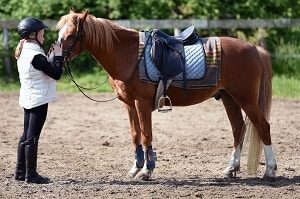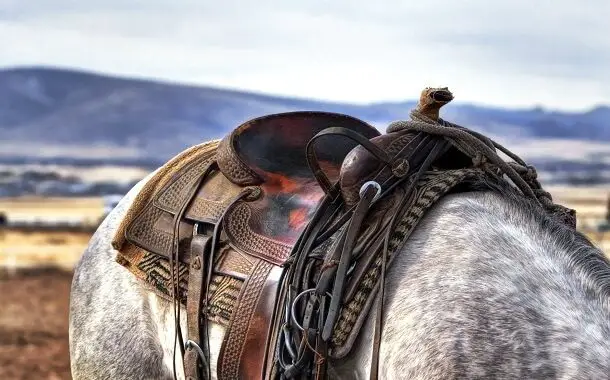How Much Does a Horse Saddle Cost?
Last Updated on February 13, 2024
Written by CPA Alec Pow | Content Reviewed by ![]() CFA Alexander Popinker
CFA Alexander Popinker
If you’re new to horseback riding or looking to upgrade your saddle, you’re probably wondering – how much does a horse saddle really cost? With prices ranging wildly from just a couple hundred to several thousand dollars, it can be hard to budget for this essential piece of equestrian gear.
In this article, we’ll break down the average costs for different types of saddles, what goes into pricing, and provide tips for getting the most value from your investment.
A proper-fitting, quality saddle is vital for both horse and rider comfort and performance. While more expensive doesn’t always mean better, purchasing the right saddle for your needs and budget pays off in the long run.
Highlights
- Expect to invest $500 to $5,000+ depending on saddle type and customization. Western, synthetic, and used saddles sit at the lower end while custom English/dressage models run highest.
- Materials, craftsmanship, brand, customization, and added features impact pricing significantly.
- Custom-fitting an existing or new saddle improves comfort and performance for horse and rider despite the higher cost.
- Used saddles provide huge savings but require careful inspection for damage compromising function.
- Account for accessories like pads, girths and leather care in your total budget.
- Ongoing maintenance ensures your saddle lasts, retains value, and provides years of riding enjoyment.
How Much Does a Horse Saddle Cost?
Saddle prices run the gamut depending on factors like type, materials, brand name, and customization. Here’s what to expect:
- Budget saddles – $200 to $500
- Mid-range saddles – $500 to $1,500
- High-end saddles – $1,500 to $3,000
- Custom saddles – $2,000 to $5,000+
The most common types of saddles fall into Western, English, and dressage categories. Western saddles tend to run cheaper while dressage and highly customized saddles are pricier. However, you can find options across the spectrum in any category.
Popular brands like Circle Y, Billy Cook, and Fabtron offer Western saddles from around $500 to $2,000. For English saddles, you’ll see names like Stubben, Butet, and Devoucoux ranging from $1,000 to $4,000+.
Dressage saddles from prestigious makers such as Amerigo, Prestige, and CWD go for $2,000 to well over $10,000.
Of course, you can also find quality saddles for under $500 if you don’t need advanced performance features. Understanding different saddle types helps determine the right balance of price and value for your riding style and horse.
According to horseridingguide.com, for example, on average, a horse saddle will cost around $500. However, the price can vary greatly, with some saddles costing as low as $100 and others reaching $8,000 or more. The pricing is influenced by factors such as the quality, materials used, and brand.
Equilineamerica.com lists various horse saddles for sale, with prices ranging from $2,775.00 for “The Pony Saddle” to $7,400.00 for “Shyny Equiline Dressage Saddle” and “Alissum Equiline Dressage Saddle”.
Chicksaddlery.com offers a “TT5210 Double T Youth Hard Seat Barrel Style Saddle With Cheetah Print Seat” for $279.99 and a “Nylon Cordura 12 Inch Youth/Pony Saddle With Suede” for $399.00.
The Main Types of Saddles
The saddle’s purpose and design affects its cost. Consider what kind of riding you’ll be doing most before deciding which type best fits your needs and budget.
Western Saddles
Western saddles have a high cantle and horn made for control and security during activities like trail riding, ranching, and rodeo events. The seat is deep with minimal leg contact. Decorative tooling and embellishments raise the prices of premium Western saddles. Expect to pay around:
- $200 to $800 for basic synthetic Western saddles
- $800 to $1,500 for mid-range leather Western saddles
- $1,500 to $3,000+ for high-end custom Western saddles
English Saddles
English saddles prioritize close contact and mobility for disciplines like jumping, dressage, and trail riding. They come in different seat types but generally have flatter, padded seats and short panels.
- $300 to $700 for basic synthetic English saddles
- $700 to $2,000 for mid-range leather saddles
- $2,000 to $5,000 for high-performance, custom leather
Dressage Saddles
Dressage saddles are designed for optimal freedom of movement and close communication with the horse. Expect a long, straight flap, smooth panels, and deep seat. Prices vary widely:
- $1,500 to $3,000 for mid-range dressage saddles
- $3,000 to $10,000+ for high-end custom dressage saddles
Specialized saddles for jumping or racing can also run up to $5,000 or more. Understanding typical pricing for different types helps set realistic expectations. But many individual factors affect what you’ll ultimately pay.
What Goes Into the Cost of a Saddle?
Several key factors influence saddle pricing:
Materials
Leather saddles command higher prices than synthetic due to durability and performance. But synthetic materials have improved, bringing the costs down on entry-level saddles.
- Leather: $500 to $5,000+
- Synthetic: $200 to $1,000
Hand-tooled leather and luxurious elements like suede lining or cushioned, padded seats raise costs. Exotic hides like ostrich leather can add thousands to the price tag!
Craftsmanship
A saddle’s quality depends heavily on the materials and skill used constructing it. Leatherworking artisans invest years honing their craft. Premier custom saddle makers charge upwards of $5,000 to $10,000 for their work.
Mass-produced saddles often cut corners reducing cost – but also comfort, durability, and value over time. Carefully inspect stitching, hardware, and shaping. It’s worth investing extra in exemplary craftsmanship.
Brand Name
In saddles, big names come with bigger price tags. Well-known companies like Herm Sprenger, Stubben, and County Saddlery carry prestige – and premium pricing.
But lesser-known custom makers can offer comparable quality. Focus on craftsmanship and fit over brand prestige alone.
Custom Fitting
Ordering a saddle customized to a horse and rider’s exact size and shape costs more upfront. But a perfect fit pays off when it comes to performance and avoiding injury. Expect to pay $2,000 to $5,000+ for full customization.
Getting a standard saddle professionally adjusted with padding or panels offers a more affordable alternative to improve the fit.
Specialized Features
Extra details for comfort, aesthetics and performance add cost:
- Custom tooling or embellishments
- Suede lining or leather upgrades
- Padded or cushioned panels and seats
- Flexible tree systems
- Shock-absorbing materials
- Specialized padding for jumping, dressage, etc.
Prioritize features that improve function rather than just flashy upgrades that drive up the price.
Is a Custom Saddle Worth the Investment?
 Ordering a saddle customized to your horse and body takes more effort and money upfront. But in the long run, a tailor-made fit provides huge benefits:
Ordering a saddle customized to your horse and body takes more effort and money upfront. But in the long run, a tailor-made fit provides huge benefits:
- Maximum comfort for horse and rider
- Reduced risk of soreness or injury
- Ideal weight distribution and communication
- Enhanced performance in your riding discipline
- Improved balance and security
Working with an experienced saddle fitter ensures proper:
- Tree width and shape
- Seat angle and dimensions
- Panel contouring to the horse’s back
- Materials to suit riding style
The process requires:
- Measurements of horse and rider
- Fitting trial sessions
- Potential model adjustments
- 12 weeks or longer build time
For a 100% custom saddle, expect to invest $2,500 to $5,000 or more. Partial customization like adjusting an existing saddle’s panels costs less.
While the upfront investment is higher, a custom saddle lasts for years when well-maintained. The comfort, performance, and longevity justify the extra cost over an ill-fitting saddle.
Buying Used Saddles – What to Look For
For significant savings, consider a quality used saddle in good condition. Gently-used models run 50-60% less than new. With careful inspection, you can find substantial value.
You might also like our articles about the cost of a pony, a horse in general, or an Akhal Teke horse.
Benefits of used saddles:
- Hundreds less than new
- Often well-broken in
- Vintage or discontinued models
- Frequently great condition
Potential downsides:
- Not professionally fitted
- Unknown history
- Wear on padding/leather
- Missing accessories
When evaluating a used saddle:
- Examine leather for tears, cracks, or rotting
- Ensure solid, even stitching
- Check wood in tree for signs of twisting or warping
- Test flexibility and mechanics of adjustable parts
- Try it on your horse; assess comfort and fit
- Ride in it yourself before purchasing
Light scuffs or creases are normal in a broken-in saddle. But damage compromising integrity and function makes a used saddle risky.
Don’t Forget About Accessories!
Beyond the saddle itself, essential accessories bump up the total investment:
- Saddle pad: $20 to $150
- Girth/cinch: $20 to $100+
- Stirrups: $50 to $300+
- Leather care products: $15 to $50
Quality saddle pads cushion the horse’s back, wick sweat, and absorb shock. Well-fitting girths prevent rubbing while keeping the saddle secure. Safety stirrups release feet in falls.
Proper leather conditioning keeps saddles supple and extends their lifespan. Consider these accessory expenses when budgeting for saddle costs.
Plan for Ongoing Saddle Maintenance
Saddles require regular care and maintenance to retain their comfort, function, and value over years of use. Expect yearly costs for:
- Professional cleaning/conditioning: $50 to $200
- At-home leather conditioning: $15 to $50
- Saddle pad/accessory replacement: $20 to $150
- Potential repairs: $100+ if leather or tree damaged
Storing saddles correctly on wide racks away from temperature extremes preserves leather and padding.
Following the manufacturer’s guidelines on care protects your investment. Quality saddles properly maintained hold their value and last for decades.
Final Words
Choosing the right saddle involves balancing your budget with your horse’s needs and your riding goals. Determine must-have features, shop smartly, and care for your saddle, and it will become a beloved riding partner for years to come!
Frequently Asked Questions
What is a good budget for a saddle?
$800 to $1,500 provides a quality leather saddle for most riding disciplines without breaking the bank. In this mid-range price point, you can find reputable brands with solid construction and value pricing on Western, English, and dressage models.
Going below $500 risks poor fit, materials, and durability. Over $1,500 gains customization, prestige brands, and high-end tack but isn’t essential for the casual rider. Set your budget based on your riding experience, discipline, and needs. Then look for sales through retailers or used saddles to meet your price point.
What is the lifespan of a saddle?
With proper care and maintenance, a high-quality leather saddle can last 20 to 40 years. Synthetic saddles average 10 to 15 years before wearing out. Factors impacting lifespan include materials, construction quality, fit, frequency of use, storage conditions, and care.
A well-made custom leather saddle fitted to one horse and rider can potentially even reach 50+ years if consistently conditioned and repaired when needed. Prioritize quality materials and craftsmanship for maximum durability.
What saddle is best for beginners?
For most disciplines, an all-purpose English saddle is a great choice for beginners. All-purpose models have flatter seats and a balance of forward and backward girth placements to accommodate different riding positions.
This versatility helps new riders learn proper position and technique. Prioritize correct fit over specialized features. Synthetic versions under $500 minimize investment for an intro saddle.
Going used can provide additional savings on a quality leather trainer. Correct fit and an adjustable gullet system provide room to grow. An all-purpose English saddle suits flat work, light jumping, and trail use, preparing new riders for their equestrian journey.


Leave a Reply
Want to join the discussion?Feel free to contribute!